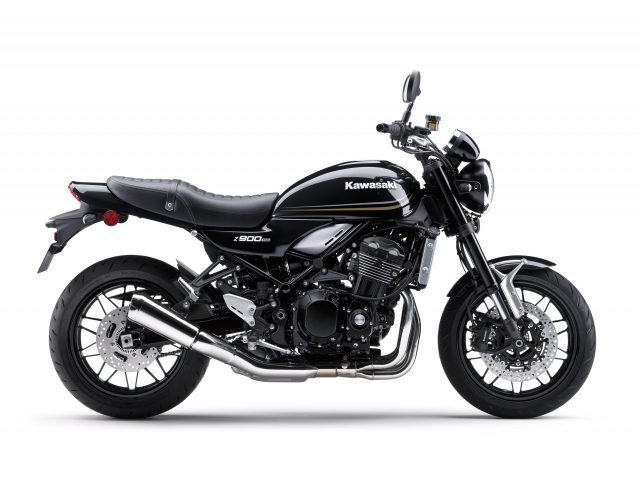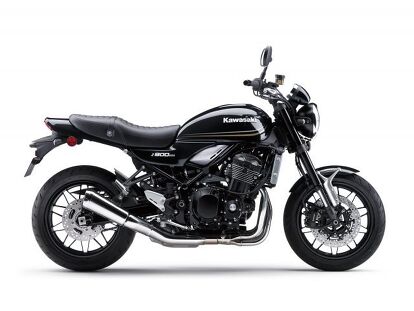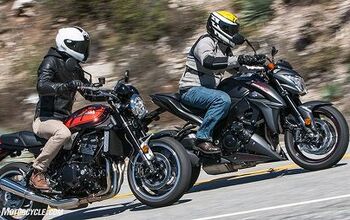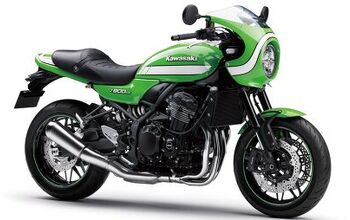2018 Kawasaki Z900RS Announced for USA
The only thing unpredictable about that announcement is that there’s no word on the Z900RS Cafe. Oh well. The Z900RS has drawn tons of interest ever since its leakage right before the big EICMA show last month, and now it’ll be North American buyers’ chance to put their money where their retro-loving mouths are – on the order of $10,999.
This one, Kawasaki says, “is the long-awaited foray into the retro genre of motorcycling… a true throwback to its 1970s predecessor, the famed Kawasaki Z1.”
“Developed for riders in search of a well-rounded bike that is not only rich in history and character, but also packed with modern technology and handling features, the Z900RS is powered by a 948cc in-line four engine, features a modern trellis frame, and modern suspension components that bring an unmatched level of performance to the retro bike category.”
And why not, since it’s totally based on the 116-rear wheel horsepower Z900 we tested here.
“The sleek sweeping contours and meticulous fit and finish of the Z1 redefined the standards of motorcycle design in the 1970s. Kawasaki has applied the same meticulous attention to detail in building the Z900RS, from the iconic teardrop gas tank to the simple uncluttered engine design, all the way down to the retro themed headlight and tail cowl.”
In-Line Four Engine & Transmission
The Z900RS, features a liquid-cooled, DOHC, 16-valve 948cc in-line four cylinder engine. “Its design and configuration offer a great balance of power and manageability, delivering strong low and mid range torque that provides all riders the reassuring feeling of control. Several engine components played a crucial role in achieving the smooth, reliable, consistent power needed for the Z900RS.” This one has a shorter first gear than the Z900, making it easier to launch, and a longer sixth gear for improved ride comfort when touring, which in turn results in improved fuel efficiency and reduced engine vibration.
Your clutch is a slip/assist unit, which prevents embarrassing wheel hop during downshifts
Kawasaki’s First Tuned Exhaust Note
Kawasaki says this is the first time it’s used sound research to craft a bike’s exhaust note: “Sound tuning on the Z900RS‘s engine was focused on the initial roar to life, idling, and low-speed riding where the rider is best able to enjoy the exhaust’s deep growl. To ensure both performance and the desired sound were achieved, every aspect of the exhaust system was scrutinized: exhaust pipe length, collector design, where to position the bends, even the density of the glass wool fibers in the silencer. More than 20 renditions of the system were tested before finding the perfect match. Clever internal construction of the pre-chamber achieves a balance of sound and performance, and at low-rpm, the exhaust escapes in a straight line, while at high-rpm the exhaust is routed through an additional passage.
The high quality stainless steel exhaust system features a 4-into-1-collector layout. The header pipes and pre-chamber are built as single unit. The exhaust headers feature a double-wall construction, which helps to minimize heat discoloration and provide protection from the elements. The 28.6 mm inner diameter of the header pipes was chosen to achieve the desired low-mid range engine performance, and the larger 38.1 mm outer wall of the header pipes provides a quality finish appearance flowing from the beautifully crafted in-line four cylinder engine. The compact stainless steel megaphone-style silencer contributes to the retro design of the Z900RS. To ensure the highest quality finish possible the header pipes, pre-chamber and silencer are all treated with a special three stage buffing process: the first is done as individual parts, the second is done once the exhaust is assembled, the third stage is a final buffing process.”
Trellis Frame
An all-new high tensile steel trellis frame was developed using Kawasaki’s advanced analysis technology, with frame tubes as straight as possible. The engine is connected at five points: front and rear of the cylinder head, behind the cylinder, and at the top and bottom of the crankcases.
Raising the front and lowering the rear a bit compared to the Z900 gives the RS that retro look; a new upper triple clamp reduces trail to keep the steering nice and light.
Suspension
A fully adjustable 41mm inverted fork and Kawasaki’s Horizontal Back-Link rear suspension should keep things on the straight and narrow. The rear shock offers adjustable rebound damping and preload.
Blakes
A radial front brake master cylinder commands a pair of four-piston radial-mount monobloc calipers gripping 300mm brake discs, the rear brake is a single piston slide-type caliper gripping a 250 mm disc. ABS is standard equipment.
Kawasaki TRaction Control (KTRC)
Kawasaki TRaction Control (KTRC) has two performance settings: Mode 1 prioritizes maximum forward acceleration, Mode 2 soothes jangled nerves by dialing things back a bit on slippery surfaces.
“When excessive rear wheel spin occurs, Mode 2 switches to three-way control, which governs the ignition timing, fuel delivery and airflow, and engine output is reduced to a level that allows the rear wheel to regain grip. This fine control results in a very natural feeling with smooth engagement and on/off transition. Riders may also elect to turn the system off to enjoy the raw feel of riding.”
Retro Active
The original 1973 Z dictated many design elements, that 4.5-gallon teardrop fuel tank being the focal point. The retro vibe also influenced the big, 170mm LED headlight, complete with convex lens and chrome ring. The duckbill tail cowl of the Z1 inspired the flowing design of the rear cowl on the Z900RS, and the oval tail light complete with surface-emitting LEDs. Analog speedo and tachometer are contrasted by a multifunctional LCD screen with black and white display.
Simple, uncluttered engine design was very important; engine fins were cast onto the cylinder head to create the image of an air-cooled engine. Long, flowing stainless steel head pipes mate to the short, low hanging megaphone silencer.
Cast aluminum wheels feature flat spokes designed to look like classic wire-spoke wheels. Designed using Kawasaki’s advanced analysis technology, the wheels’ light weight contribute to the bike’s light handling and retro design.
Yours in Metallic Flat Spark Black or Candy Tone Brown. What’s all thing going to cost me, you axe? $10,999 to $11,199, says Kawasaki.
Accessorize
Kawasaki Genuine Accessories offers a frame slider set, front axle sliders, radiator trim, tank pad, grip heater set, Ergo-Fit reduced reach seat, and a smoked wind deflector. Also a retro Kawasaki tank emblem set, oil filler cap (Black, Gold or White), KYB fork cap set (Black or Gold), silver gauge trim, passenger grab bar, side grip set, Akrapovic slip on muffler and a center stand.
More by John Burns

















































































Comments
Join the conversation
no offense, i like reading your articles but you guys need to proof read more. misspelled words are really an eye sore...
This needs to be green. GREEN I SAY!!